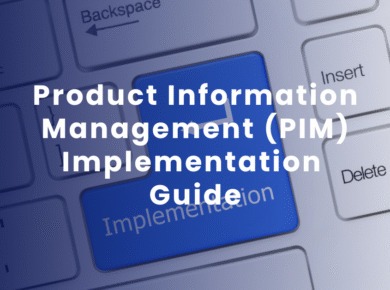How Will GenAI Redefine the Hybrid Shopper Experience? Read Blog Holiday shopping

Discovering Advanced Product Information Management (PIM) Capabilities Enterprises Demand in 2025
In the dynamic world of digital commerce, Product Information Management (PIM) systems have become indispensable for enterprises striving to optimize operations and deliver superior customer experiences. As we step into 2025, the expectations from PIM solutions are evolving, with enterprises demanding advanced capabilities to keep pace with market complexities and consumer expectations. This blog delves into the new and sophisticated PIM functionalities that are reshaping enterprise strategies and driving digital transformation.
1. Contextualized and Personalized Product Experiences
Modern consumers expect more than static product listings; they demand contextually relevant and personalized experiences. Enterprises are leveraging advanced PIM System to dynamically organize and present product information based on real-time consumer behavior, market trends, and seasonal shifts. These solutions provide seamless updates across multiple platforms, ensuring that customers always access accurate and up-to-date information. The integration of AI-driven tools allows businesses to craft tailored experiences that resonate with diverse audiences, enhancing loyalty and driving sales.
2. Revolutionizing Content Creation with NLG Features
The manual creation of engaging, detailed product descriptions is a time-consuming process, especially for enterprises managing extensive catalogs. In 2025, product information management solutions are equipped with Natural Language Generation (NLG) capabilities, transforming how content is produced. These systems convert master data into rich, human-like descriptions at scale, ensuring consistency and optimization across all channels. This innovation not only accelerates time-to-market but also reduces resource dependency, enabling businesses to focus on strategic initiatives.
3. Breaking Language Barriers with Automated Translation
Globalization necessitates the seamless localization of product information. Advanced PIM systems integrate automated and machine-assisted translation tools to convert product data into multiple languages efficiently. These solutions ensure cultural and linguistic accuracy while significantly reducing the time and cost associated with manual translations. By streamlining multilingual data management, enterprises can expand their global footprint more effectively.
4. Harnessing Digital Shelf Analytics for Competitive Edge
In an era dominated by eCommerce, understanding digital shelf performance is critical. Digital Shelf Analytics (DSA) integrated into PIM systems allows enterprises to monitor and optimize their online presence. By analyzing metrics such as product content, pricing, availability, and reviews, businesses gain actionable insights to refine their strategies. These insights empower enterprises to enhance product visibility, improve customer engagement, and drive higher sales conversions.
5. Leveraging AI for Enhanced Content Optimization
Artificial intelligence has become a cornerstone of modern PIM solutions. AI-driven systems analyze product information in real-time, ensuring compliance with business rules and industry best practices. Tools like OpenAI integration enable businesses to generate creative, high-quality content effortlessly. By automating repetitive tasks and improving data reliability, AI-powered PIM systems free up resources and support innovation, positioning enterprises for sustained growth.
6. Ensuring Compliance with Global Standards and Seamless Synchronization
Adhering to industry standards and maintaining data consistency are crucial for enterprises operating in diverse markets. Advanced PIM systems feature predefined data models that support seamless updates and synchronization of product information across networks. These capabilities enable businesses to ensure compliance, streamline processes, and maintain competitive parity in global markets.
7. Integrating Cutting-Edge Technologies
The integration of emerging technologies into PIM solutions is redefining the possibilities for enterprises. Features such as augmented reality (AR) and virtual reality (VR) provide immersive product experiences, while blockchain enhances supply chain transparency and security. Additionally, Internet of Things (IoT) integration facilitates real-time updates and insights, enabling businesses to make data-driven decisions. These technological advancements allow enterprises to innovate and stand out in an increasingly competitive market.
8. Smoothing Supply Chain Operations and Vendor Management
In 2025, enterprises are focusing on improving supply chain efficiency and strengthening vendor relationships. Advanced PIM systems facilitate seamless communication and data sharing across supply chain partners, ensuring accurate and timely product information. By centralizing data, businesses can reduce errors, enhance collaboration, and streamline procurement processes. Furthermore, PIM systems enable better vendor performance tracking and evaluation, helping organizations build robust partnerships and drive operational excellence.
Driving Business Success with Advanced PIM Solutions:
The expectations from PIM systems in 2025 reflect a shift towards more advanced, dynamic, and integrated functionalities. Enterprises no longer view PIM as merely a data management tool but as a strategic enabler of growth and innovation. By embracing capabilities such as automated content creation, multilingual translation, AI-driven optimization, and digital shelf analytics, businesses can meet the demands of modern commerce.
Among the available platforms, Pimcore stands out as a highly versatile and robust PIM solution for enterprises in 2025. With its flexible microservices-based architecture, scalability, and powerful integration capabilities, Pimcore enables businesses to centralize and optimize product data management seamlessly. Its flexibility in adapting to specific industry needs and its ability to incorporate cutting-edge technologies make it the preferred choice for enterprises aiming to stay ahead in the competitive landscape.
As new technologies and operational priorities continue to shape the market, advanced PIM solutions like Pimcore will remain at the forefront of enterprise success. By empowering organizations to deliver exceptional customer experiences and achieve their strategic objectives, these platforms are redefining the future of product information management.
Get in Touch With Us!
Schedule time with us to walk through the Innowinds Solutions and Services.
Latest Resources
How Unified Data Can Keep You Ahead This Holiday Read Blog As
Enterprise Data Management in Transition: 2026 Trends and AI-Driven Shifts Read Blog
Unlocking Growth: Why PIM DAM Integration Is a Strategic Imperative Read Blog
Mastering Product Data Syndication: A Business-Centric Approach Read Blog Why Accurate Product
The Hidden Costs of Missing Metadata in Digital Asset Management Read Blog
Key Takeaways: Identify the Right Time for PIM: Gain clarity on identifying
PIM vs MDM: What’s the Difference and When to Use Each? Read
Questions to Ask When Choosing a PIM Vendor? - Part 2 Read
Questions to Ask When Choosing a PIM Vendor? - Part 1 Read









